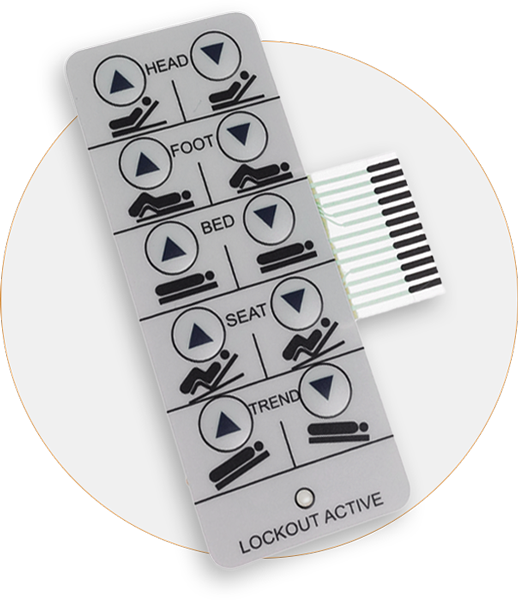Understanding the Functionality of Membrane Layer Switches Over for Individual User Interface Devices
The performance of membrane layer switches over stands for a considerable development in individual interface style, integrating efficiency with visual convenience. As markets increasingly prioritize user experience, comprehending the nuances of membrane switch innovation becomes necessary.
What Are Membrane Buttons?
Membrane layer buttons are cutting-edge user interface devices that facilitate user interaction with electronic equipment. These versatile components include multiple layers, consisting of a visuals overlay, spacer, and a published circuit layer. The design allows for a seamless combination right into different digital devices, enhancing both the visual and useful aspects of interface.
Membrane switches are commonly employed in a wide variety of applications, from family home appliances to industrial machinery and medical devices. Their building generally includes a thin account, making them an ideal choice for small layouts. The responsive feedback supplied by these switches can be crafted to satisfy particular user preferences, guaranteeing efficient communication in between the customer and the tool.
Longevity is another significant benefit of membrane layer buttons, as they are immune to dust, dampness, and chemicals, which enhances their lifespan sought after atmospheres. In addition, these buttons can be customized in terms of form, size, and visuals design, enabling branding and user-specific attributes. Overall, membrane switches stand for a functional option for improving user experience in digital devices, combining performance with aesthetic charm in an efficient way.
How Membrane Changes Job
Operating on a simple concept, membrane switches over make use of a layered building to sign up customer input successfully. Each button contains numerous layers, consisting of a published circuit layer, a spacer layer, and a leading visuals layer, which are made to collaborate flawlessly. When an individual presses the top layer, it presses the spacer layer, bringing the conductive aspects of the circuit layer into contact with each other.
This call develops a closed circuit, signaling the tool to execute a particular function. The style permits numerous arrangements, including tactile responses, which can boost the customer experience by supplying a physical feeling upon activation. The materials used in membrane layer switches commonly consist of flexible substrates, such as polyester or polycarbonate, which ensure sturdiness and strength versus wear and tear.

Trick Benefits of Membrane Switches

One more significant benefit is their compactness. Membrane layer buttons are thin and light-weight, which enables suppliers to conserve space in their gadgets without giving up capability. This function is specifically advantageous in applications where weight and quantity are vital considerations.
Additionally, membrane buttons are immune to dust, wetness, and chemicals, boosting their toughness. This durability extends their lifespan and lowers the requirement for frequent substitutes, leading to cost financial savings over why not look here time.
Additionally, the tactile comments provided by membrane layer switches can be maximized to enhance individual interaction. They can include attributes such as raised buttons or distinct clicks, improving functionality and customer experience.
Applications Across Industries
Interface devices using membrane switches are common in a vast range of markets, showcasing their flexibility and functionality. Membrane Switch. In the medical market, membrane switches are indispensable to devices such as diagnostic devices and person monitoring systems, where their sturdiness and simplicity of cleansing are crucial for preserving health requirements. In the auto market, these switches are utilized in control panel controls and infomercial systems, offering a sleek and modern-day user interface for individuals.
In addition, the consumer electronics industry advantages from membrane layer buttons in devices and portable tools, where portable style and straightforward interfaces improve user experience. Industrial applications also leverage membrane switches over for control board in equipment and automation systems, highlighting their toughness and resistance to extreme atmospheres.
In the aerospace and defense industries, membrane layer buttons are used in cockpit controls and equipment, where reliability and efficiency under extreme conditions are read this post here extremely important. Additionally, the gaming sector increasingly incorporates membrane layer switches in controllers and arcade machines, adding to an interesting individual experience. Generally, the flexibility of membrane layer switches over enables their widespread usage throughout many sectors, emphasizing their relevance in modern user interface layout.
Future Trends in Membrane Layer Switch Over Modern Technology

In addition, using advanced products, such as polycarbonate and polyester movies, is anticipated to increase, supplying enhanced resilience and resistance to environmental stressors. These products contribute to the total longevity of membrane layer buttons, making them ideal for harsher industrial applications.
Moreover, the unification of clever technology, including IoT connectivity, will allow membrane switches to interact with various other tools and systems, helping with a much more interactive individual experience. This pattern straightens with the expanding need for clever devices across different markets, from medical care to customer electronic devices.
Finally, personalization choices are prepared for to increase, permitting suppliers to develop bespoke options customized to certain individual requirements and preferences. These advancements will position membrane layer buttons as crucial parts in the advancement of individual interface innovation.
Final Thought
To conclude, membrane layer changes represent a crucial innovation in individual this hyperlink interface innovation, offering a reliable and flexible solution for varied digital applications. Their layered construction promotes small design, while attributes such as responsive comments enhance individual interaction. The resilience against environmental variables better strengthens their utility throughout several sectors. As improvements in material scientific research and touch sensing modern technologies proceed, the performance and applicability of membrane buttons are expected to increase, strengthening their significance in contemporary electronic devices.